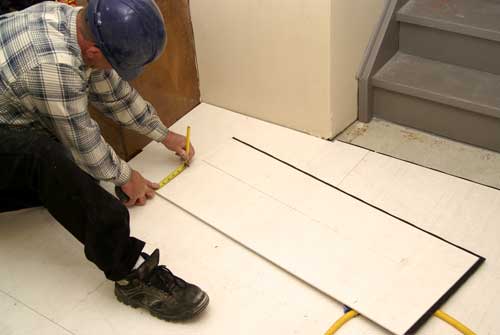September is the month when Canadians everywhere are most likely to think about finishing their basement. It’s also the month when we’re most likely to make design mistakes that lead to mold, dampness and musty basement smells. Success or failure begins at floor level, and the best flooring strategies are different than the way basements are traditionally finished.
Avoiding Musty Basements
Twenty years ago, state-of-the-art finished basement floors were typically nothing more than carpet laid over thick underpad directly on concrete. As it turns out, this is a sure-fire way to create that musty basement smell that’s so common and so disliked. As humid, summertime air enters carpet, it seeps down into the pile, cooling as it goes. If this  air cools enough, it condenses, forming small droplets of liquid water right in the underpad. Even a wooden subfloor frame built on the concrete virtually guarantees to grow hidden mold under your feet, and the problem with both these options is the same. It puts biodegradable material directly in contact with potentially damp concrete. Microbes never miss an opportunity, and that’s why food plus water always equals rot.
air cools enough, it condenses, forming small droplets of liquid water right in the underpad. Even a wooden subfloor frame built on the concrete virtually guarantees to grow hidden mold under your feet, and the problem with both these options is the same. It puts biodegradable material directly in contact with potentially damp concrete. Microbes never miss an opportunity, and that’s why food plus water always equals rot.
The first major breakthrough in basement subfloor technology happened about ten years ago, and included microbe-proof, inorganic material for the critical interface between the underside of the subfloor and the concrete basement floor.
Mold-Proof Subfloors
Products like Subflor and DRIcore came out of this initial wave of innovation and they continue to work well today. They’re 24-inch by 24-inch interlocking tiles made of wood-based oriented strand board (OSB), with a layer of dimpled plastic underneath. The plastic provides a sealed air space beneath the subfloor, creating a little insulation and a microbe-proof barrier between wood and concrete. A product called OvrX is similar, except that it includes a layer of foam underneath the OSB, instead of dimpled plastic. The subfloor tiles go down, then the finished floor on top.
I know from experience that all three of these OSB-based subfloor tiles work well, though they do have two limitations:
- Their small 24-inch x 24-inch tile size makes installation move forward more slowly than it could be.
- The rigid nature of the tiles means they need to be shimmed over uneven basement floors – a rather common problem in many basements, both old and new.
Try Tyroc
Tyroc is the next evolution in basement subfloor technology, and it’s substantially different than OSB systems. I’ve been testing Tyroc at my own place for about a year and I installed 800 sq. ft. of it in a condominium for sound reduction this past winter.
At 16 x 48 inches, each panel is narrow enough for easy transport, yet long enough to cover floors quickly. The product is made entirely of recycled, inorganic material, making it physically flexible and completely unappetizing for microbes.
Each Tyroc panel has two layers. The bottom is made of recycled rubber and plastic – about 28 used tires and 200 lbs of old bottles for one typical basement’s worth of Tyroc. This bottom layer is molded into a raised checkerboard pattern that creates 1/8-inch of air space for drainage of small amounts of water, in the event of an unexpected leak. The top layer is made of magnesium oxide, a mineral that’s mined from the earth, then combined with water to harden in sheet form. I did notice a rubber-like smell during installation, but it disappeared afterwards.
Finishing a basement is trickier than it looks because optimal building practices for above-ground spaces don’t always transfer directly below ground. Get the floor details right and you’ll go a long way ensuring a warm, dry space with excellent air quality.



